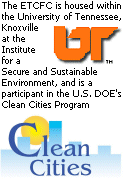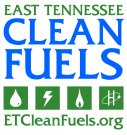
 
A great resource for information on alternative fuels is the Alternative Fuels Data Center (AFDC). At the end of each description is a link to the information on that site for each fuel. Additional links to offsite information on alt fuels can be found on the Online Resources page.
| > |
Biodiesel (B20 and B100)
By definition, biodiesel is...
"A biofuel produced through transesterification, a process in which organically-derived oils are combined with alcohol (ethanol or methanol) in the presence of a catalyst to form ethyl or methyl ester. The biomass-derived ethyl or methyl esters can be blended with conventional diesel fuel or used as a neat fuel (100% biodiesel). Biodiesel can be made from soybean or rapeseed oils, animal fats, waste vegetable oils, or microalgae oils."
{From the On-line Medical Dictionary definition of biodiesel.}
|
|
| FUEL & FUEL TAX INFO |
|
In 2001, the amount of gasoline and diesel sold in TN (Prime Supplier Sales - from the EIA) was:
Gasoline: 3.529 billion gallons
Diesel: 1.301 billion gallons
|
|
In the state of TN, current gasoline and diesel taxes are as follows:
Gasoline:
- State tax - 21.4¢; Fed. tax - 18.4¢
Diesel:
- State tax - 18.4¢; Fed. tax - 18.4¢
|
|
|
|
|
Biodiesel is the natural equivalent to diesel. Diesel comes from petroleum, a nonrenewable resource, while biodiesel comes from the organic sources listed above, which are all renewable resources. It is safe for the environment, biodegradable and produces less air pollution than diesel fuel.
"Every gallon of biodiesel displaces 0.95 gallons of petroleum-based diesel over its life cycle. It is also very energy efficient. For every unit of fossil energy used to produce biodiesel, 3.37 units of biodiesel energy are created. Additionally, biodiesel reduces the amount of carbon dioxide (CO2) being released into the atmosphere. It releases less fossil CO2 than does conventional diesel, and the crops used to produce biodiesel absorb large amounts of CO2 as they grow. And because biodiesel is nontoxic and biodegradable, it is an excellent fuel for use in fragile environments such as estuaries, lakes, rivers, and national parks."
{From the U.S. DOE's Biofuels Web site description of biodiesel.}
 Biodiesel is also unique in that using a mix of at least 20% biodiesel (B20) can provide relief from EPAct and purchasing a percentage of annual new vehicle purchases as AFVs. The EPAct credit for fleets using B20 is one credit per 450 gallons of B20 used. Biodiesel is also unique in that using a mix of at least 20% biodiesel (B20) can provide relief from EPAct and purchasing a percentage of annual new vehicle purchases as AFVs. The EPAct credit for fleets using B20 is one credit per 450 gallons of B20 used.
Biodiesel: Information and Document Links
• AFDC - biodiesel
• Griffin Industries in Cold Spring, Kentucky; their product homepage, Bio G-3000.
• "Biodiesel--the Clean, Green Fuel for Diesel Engines" - NREL, May 2000 (pdf - 241 KB)
• "Biodiesel Handling and Use Guidelines" - NREL, 2004 (pdf - 1.7 MB)
• "An Overview of Biodiesel and Petroleum Diesel Life Cycles" - DOA + DOE, May 1998 (pdf - 410 KB)
• "Biodiesel - Technical Assistance Fact Sheet" - Clean Cities, May 2001 (pdf - 452 KB)
• EPA Fact Sheet on biodiesel - March 2002 (pdf - 72 KB)
|
| > |
Electricity
Yes, you can run a vehicle on your regionally produced electricity! Certain vehicles, like GM's EV1 and Toyota's RAV4 EV (both sold only in California) literally plug-in just like you would plug-in a lamp at your house. Some utilize inductive plug-in systems and some utilize conductive plug-in systems (not much difference to the consumer), but all of them utilize electricity to run via batteries that store charge for some period of time. Most electric vehicles don't attain the range that the traditional gasoline=powered vehicle does (more like around 150 miles), but they can utilize electricity produced in any way! You can utilize power from your local grid, or you can produce your own power via more renewable fuels like solar and wind. And for folks like me who purchase Green Power at their homes, if I had an electric vehicle it would (theoretically) run on renewable power. Yea, that's right, that means I would be using an air-pollution free vehicle (and that's considering the full fuel cycle!).
Electricity: Information and Document Links
• DOE - electricity
• EPA Fact Sheet on electric vehicles - March 2002 (pdf - 72 KB)
| | > |
Ethanol (E85)
Ethanol (ethyl alcohol, grain alcohol, EtOH) is a clear, colorless liquid with a characteristic, agreeable odor. Ethanol can be produced from any biological feedstocks that contain appreciable amounts of sugar or materials that can be converted into sugar such as starch or cellulose. Sugar beets and sugar cane are examples of feedstocks that contain sugar. Corn contains starch that can relatively easily be converted into sugar. A significant percentage of trees and grasses is made up of cellulose, which can also be converted to sugar, although with more difficulty than required to convert starch.
The ethanol production process starts by grinding up the feedstock so it is more easily and quickly processed in the following steps. Once ground up, the sugar is either dissolved out of the material or the starch or cellulose is converted into sugar. The sugar is then fed to microbes that use it for food, producing ethanol and carbon dioxide in the process. A final step purifies the ethanol to the desired concentration. Ethanol is also made from a wet-milling process. Many larger ethanol producers use this process, which also yields products such as high-fructose corn sweetner. The closest producer of ethanol to East TN is in Loudon County - A.E. Staley - which uses the wet milling process to produce ethanol as well as items such as corn syrup.
Ethanol is being used more and more as an alt fuel in the U.S. today, with areas like Minnesota using E85 extensively compared to only a few years ago. (E85 is the final product when you mix denatured ethanol 85% with 15% gasoline.) Ethanol has many benefits for use as an alt fuel including
- not only is it produced domestically, it is a renewable fuel, versus crude oil (which gasoline and diesel are made from that is a nonrenewable fuel -- there is a finite amount of crude oil left in the Earth),
- it is used in flex-fuel vehicles (FFVs), which allow the owner to fill-up with either E85 or gasoline at any point in time (FFVs have fuel sensing technology inside that constantly monitor the fuel oxygen content and adjust the vehicle's air-to-fuel ratio accordingly to optimize both fuel and vehicle performance),
- it can reduce global warming gas releases by up to 80% as compared to today's convetional technology gasoline vehicle.
Ethanol: Information and Document Links
• AFDC - ethanol
• EPA Fact Sheet on ethanol - March 2002 (pdf - 72 KB)
• A.E. Staley - denatured ethanol
| | > |
Hydrogen
Hydrogen is not really a "fuel" per se -- it is an energy carrier. In most cases, the "H2" is not burned like the other alternative fuels (although it can be, like in BMW's 750hL and 745h, another clean energy option). In a fuel cell, the hydrogen atom, when fed into the anode catalyst, is split into a proton and an electron which take different paths to the cathode. The proton passes through the electrolyte, while the electron travels around the electrolyte, creating an electric current. They are reunited at the cathode with the hydrogen (that's the proton), which is also fed oxygen (or air), where the combined mixture creates water vapor.
There are several different types of fuel cells, including phosphoric acid, proton exchange membrane, molten carbonate, solid oxide, zinc air and others. Each has different qualities (like operating in a certain temperature range) that make it more useful for certain applications. The one being utilized most often for automotive applications is the Proton Exchange Membrane fuell cell, also called PEM.
The hydrogen "fuel" can come from several different sources to power a fuel cell. Hydrogen itself can be used directly, or a reformer can be used to remove the hydrogen from a hydrocarbon-based fuel like gasoline, methanol, or natural gas. Hydrogen can be stored either as a gas or a liquid for powering an AFV, with some automakers test vehicles like Mercedes-Benz and BMW's running on liquid hydrogen.
Hydrogen and Fuel Cells: Information and Document Links
• AFDC - hydrogen
• EPA Fact Sheet on fuel cells - March 2002 (pdf - 72 KB)
| | > |
Natural Gas (CNG and LNG)
"Natural gas" is a naturally occurring mixture of hydrocarbon & non-hydrocarbon gases found in porous geological formations (reservoirs) beneath the earth's surface. It is colorless and odorless; odorants (i.e., tert-butyl Mercaptan) are added for safety purposes. It is one of the world's leading alternative fuels and has been in use for over 70 years. Natural gas is made up of mostly methane (typically over 90%), but also contains some ethane, propane, isobutane and a few other gases in very small quantities. In addition to fuel use, natural gas is a feedstock (hydrogen source) for ammonia production and a source of light hydrocarbons (i.e., ethane, propane, butane) for chemical synthesis or liquified gas products.
As a transportation fuel, natural gas offers several key benefits over other alt fuels:
- As a gas, it does not pool when refueling but dissipates in air
- Home and workplace units (compressors and storage tanks) are now available for convenient on-site refueling
- The significant fuel-cycle air emissions reductions are rivaled only by propane among the alternative fuels
- Natural gas is the most inexpensive alt fuel and can save users significantly over a year (up to 40% in some areas!)
Natural gas: Information and Document Links
• AFDC - natural gas
• EPA Fact Sheet on compressed natural gas - March 2002 (pdf - 76 KB)
• EPA Fact Sheet on liquefied natural gas - March 2002 (pdf - 72 KB)
| | > |
Propane [LPG and LP Gas]
|
|
| PROPANE TAX INFO |
|
In the state of TN, current propane taxes are as follows:
- State tax - 14.0¢
- Federal tax - 13.6¢
|
|
|
|
|
By definition, propane is...
"A heavy gaseous hydrocarbon, C3H8, of the paraffin series, occurring naturally dissolved in crude petroleum, and also made artificially."
{From the On-line Medical Dictionary definition of propane.}
While "LPG" stands for liquified petroleum gas, the propane used in the U.S. comes in approximately equal parts from petroleum refining and natural gas processing. About 90% of the propane used in the U.S. is domestically produced. Additionally, while the chief constituent of propane is propane in the U.S. (typically at least 90%), propane also consists of propylene, butane, butylene, and isobutane. Some facts about propane:
- Propane tanks are filled to no more than 80% capacity (there is an automatic shutoff on the tanks), to allow for liquid expansion as ambient temperature rises.
- Propane costs in fleets typically range from 5% to 30% less than those of gasoline.
- Range on LPG is somewhat less than that of comparable gasoline-powered vehicles; however, power, acceleration, payload, and cruise speed are comparable with those obtained with an equivalent internal-combustion engine.
- Some fleets report 2 to 3 years longer service life and extended time intervals between required maintenance. However, manufacturers and converters recommend conventional maintenance intervals.
- Propane gas is the most widely used alternative fuel, with nearly 4 million vehicles worldwide running on propane. Over 350,000 vehicles of various types run on propane in the U.S.
{From the AFDC Web site.}
Propane: Information and Document Links
• AFDC - propane
• EPA Fact Sheet on propane - March 2002 (pdf - 72 KB)
|
|
|









